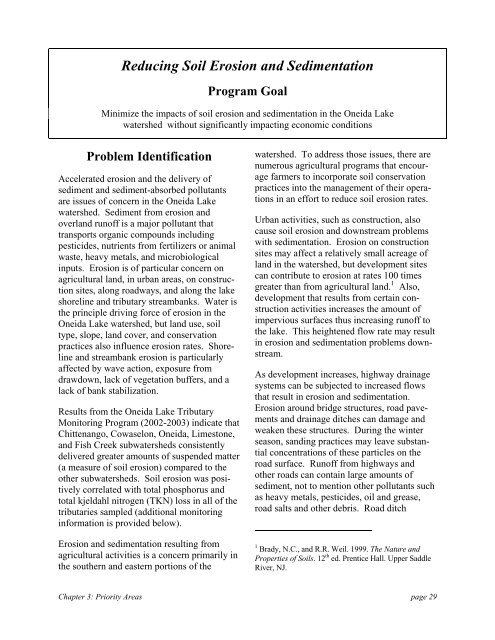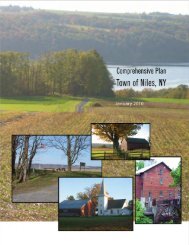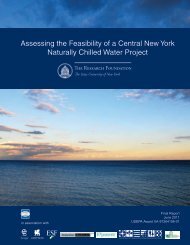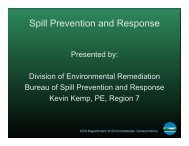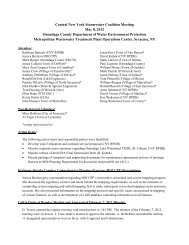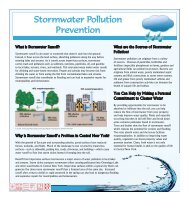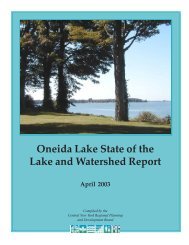A Management Strategy for Oneida Lake and its ... - CNY RPDB Home
A Management Strategy for Oneida Lake and its ... - CNY RPDB Home
A Management Strategy for Oneida Lake and its ... - CNY RPDB Home
Create successful ePaper yourself
Turn your PDF publications into a flip-book with our unique Google optimized e-Paper software.
Reducing Soil Erosion <strong>and</strong> Sedimentation<br />
Program Goal<br />
Minimize the impacts of soil erosion <strong>and</strong> sedimentation in the <strong>Oneida</strong> <strong>Lake</strong><br />
watershed without significantly impacting economic conditions<br />
Problem Identification<br />
Accelerated erosion <strong>and</strong> the delivery of<br />
sediment <strong>and</strong> sediment-absorbed pollutants<br />
are issues of concern in the <strong>Oneida</strong> <strong>Lake</strong><br />
watershed. Sediment from erosion <strong>and</strong><br />
overl<strong>and</strong> runoff is a major pollutant that<br />
transports organic compounds including<br />
pesticides, nutrients from fertilizers or animal<br />
waste, heavy metals, <strong>and</strong> microbiological<br />
inputs. Erosion is of particular concern on<br />
agricultural l<strong>and</strong>, in urban areas, on construction<br />
sites, along roadways, <strong>and</strong> along the lake<br />
shoreline <strong>and</strong> tributary streambanks. Water is<br />
the principle driving <strong>for</strong>ce of erosion in the<br />
<strong>Oneida</strong> <strong>Lake</strong> watershed, but l<strong>and</strong> use, soil<br />
type, slope, l<strong>and</strong> cover, <strong>and</strong> conservation<br />
practices also influence erosion rates. Shoreline<br />
<strong>and</strong> streambank erosion is particularly<br />
affected by wave action, exposure from<br />
drawdown, lack of vegetation buffers, <strong>and</strong> a<br />
lack of bank stabilization.<br />
Results from the <strong>Oneida</strong> <strong>Lake</strong> Tributary<br />
Monitoring Program (2002-2003) indicate that<br />
Chittenango, Cowaselon, <strong>Oneida</strong>, Limestone,<br />
<strong>and</strong> Fish Creek subwatersheds consistently<br />
delivered greater amounts of suspended matter<br />
(a measure of soil erosion) compared to the<br />
other subwatersheds. Soil erosion was positively<br />
correlated with total phosphorus <strong>and</strong><br />
total kjeldahl nitrogen (TKN) loss in all of the<br />
tributaries sampled (additional monitoring<br />
in<strong>for</strong>mation is provided below).<br />
Erosion <strong>and</strong> sedimentation resulting from<br />
agricultural activities is a concern primarily in<br />
the southern <strong>and</strong> eastern portions of the<br />
watershed. To address those issues, there are<br />
numerous agricultural programs that encourage<br />
farmers to incorporate soil conservation<br />
practices into the management of their operations<br />
in an ef<strong>for</strong>t to reduce soil erosion rates.<br />
Urban activities, such as construction, also<br />
cause soil erosion <strong>and</strong> downstream problems<br />
with sedimentation. Erosion on construction<br />
sites may affect a relatively small acreage of<br />
l<strong>and</strong> in the watershed, but development sites<br />
can contribute to erosion at rates 100 times<br />
greater than from agricultural l<strong>and</strong>. 1 Also,<br />
development that results from certain construction<br />
activities increases the amount of<br />
impervious surfaces thus increasing runoff to<br />
the lake. This heightened flow rate may result<br />
in erosion <strong>and</strong> sedimentation problems downstream.<br />
As development increases, highway drainage<br />
systems can be subjected to increased flows<br />
that result in erosion <strong>and</strong> sedimentation.<br />
Erosion around bridge structures, road pavements<br />
<strong>and</strong> drainage ditches can damage <strong>and</strong><br />
weaken these structures. During the winter<br />
season, s<strong>and</strong>ing practices may leave substantial<br />
concentrations of these particles on the<br />
road surface. Runoff from highways <strong>and</strong><br />
other roads can contain large amounts of<br />
sediment, not to mention other pollutants such<br />
as heavy metals, pesticides, oil <strong>and</strong> grease,<br />
road salts <strong>and</strong> other debris. Road ditch<br />
1 Brady, N.C., <strong>and</strong> R.R. Weil. 1999. The Nature <strong>and</strong><br />
Properties of Soils. 12 th ed. Prentice Hall. Upper Saddle<br />
River, NJ.<br />
Chapter 3: Priority Areas page 29


